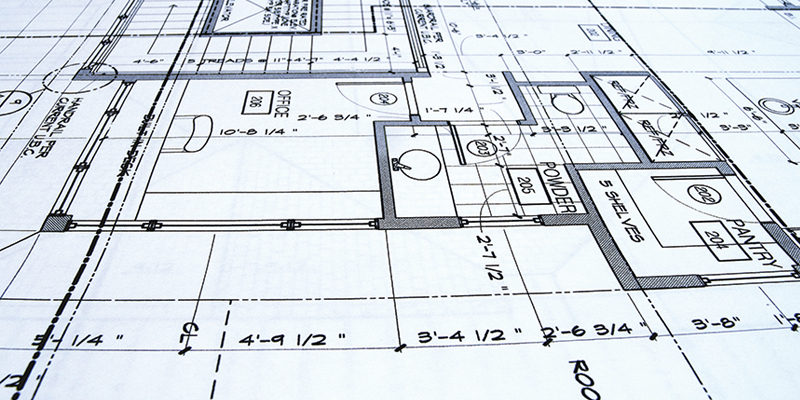More and more builders are doing away with expensive model homes, instead using artists’ conceptions to show buyers the completed house’s exterior, along with detailed floor plans of the interior. In light of this trend, it has become incumbent upon would-be buyers to learn how to “read” what they are being shown.
Floor plans, or the far more detailed drawings called blueprints, have a language all their own. With dozens of symbols and lines going hither and yon, they are your road map to exactly how the house you are considering will “live” once you are in it.
A plan tells you the house’s size, circulation pattern, room layout and the locations of doors, windows and stairs. Although it offers only a static two-dimensional view of the property, it reveals enough information so that a practiced eye can picture how the house works – or doesn’t.
Typically, the rooms are labeled so it’s easy to see how they are supposed to function. But sometimes designers get a little too tricky – labeling, for example, an extra bedroom as an office or den. Of course, turning what is essentially square footage inside four walls into something more special than a simple bedroom costs extra. But the plan rarely tells you that.
You would know that if you were touring a model home: You’d see that the room in question contained built-in bookcases and special lighting, and that those features were upgrades. But without a sample house to behold, prospects are left to visualize for themselves.
Here’s a very basic tutorial on how to read a floor plan.
Start at the front door. Sometimes difficult to find, especially on apartments that span an entire floor or share the floor with only one or two other units, the entry point allows you to “walk” into the house with your eyes. From there, you can see how you can move from room to room.
As you enter, try to get a feel for how the plan plays out. One important element to look for is a corridor that creates a view from the front of the house straight to the back. Now roam from room to room. In each room, look at the window and door placement. These key design elements can enhance or limit a room’s usefulness.
You should see figures in each room that tell you their size. Sometimes, the plan will say something like “12 by 12” or “10 by 10.” In other cases, a number is shown beside each wall.
When yours truly built his house 15 years ago, he found a plan he liked, but failed to pay attention to the little numbers. Now, he and his bride of nearly 34 years live in a house that is far too large for just two people. (We love the place – the Missus vows to never leave – but it is much bigger than we need.)
The moral here is to pay attention to the numbers. The house may be large overall, but each room may be small – perhaps too small. If you can’t visualize the size of a room, go home, take out a tape measure and mark off the dimensions to get an idea of the actual space.
With blueprints, the architectural symbols would tell whether the windows are single- or double-hung, meaning they either open from the bottom up (single hung) or also open from the top down (double). Floor plans aren’t as detailed, so you’ll have to refer to the builder’s list of standard and upgraded features.
Pay attention to the window placement, as they affect both light and views. And make sure you understand how the doors open and close. Typically, a door is drawn as a straight line protruding out from the wall with an arc connecting that line to the wall. The arc indicates the direction the door opens. Make sure doors open in a way that minimizes floor space lost.
If a door is drawn as a line between two walls, it is a sliding door. If the line doesn’t reach to another wall, it is a pocket door that slides into the wall. Bi-fold doors are shown as two arcs that don’t connect; French doors are shown as two larger arcs that do connect.
In some cases, the builder will show furniture to help you imagine how the space might be furnished. But it won’t tell you the size of the furniture, so yours may be too big for the same wall. Of course, there’s no law saying you have to put your couch where the builder does.
The fireplace is another design feature to look for. It is shown as a rectangle sticking out from the wall. Fireplaces are great, but again, they take away from usable space because you can’t put furniture against them like you can a plain wall.
Drawn as a series of parallel lines with an arrow indicating their direction, stairs also eat up a significant amount of floor space. So look for their placement.
In the kitchen, the symbols are often self-explanatory. Ditto for the bathrooms. But pay attention to their placement and how they relate to each other. Again, it might be a good idea mark off these spaces when you go home to see how they work in real life.
The plan may or may not tell you the height of the ceilings, but many houses these days are built with extra-high, two-story ceilings. In these spaces, the lower floor will show a dashed line, while the upper floor will be labeled something like “open to below.”
Bear these floor plan-reading tips in mind, and you’ll be well on your way to making an informed decision.
Lew Sichelman has been covering real estate for more than 30 years. He is a regular contributor to numerous shelter magazines and housing and housing-finance industry publications. Readers can contact him at lsichelman@aol.com.





